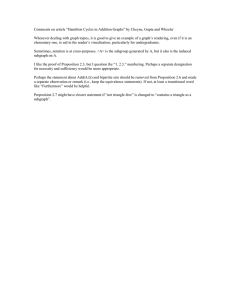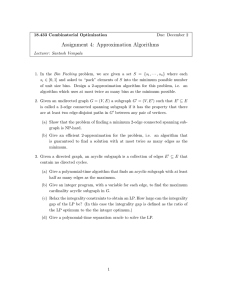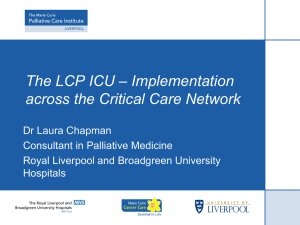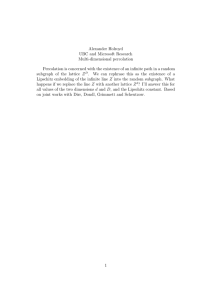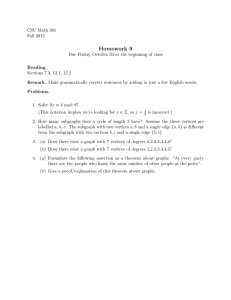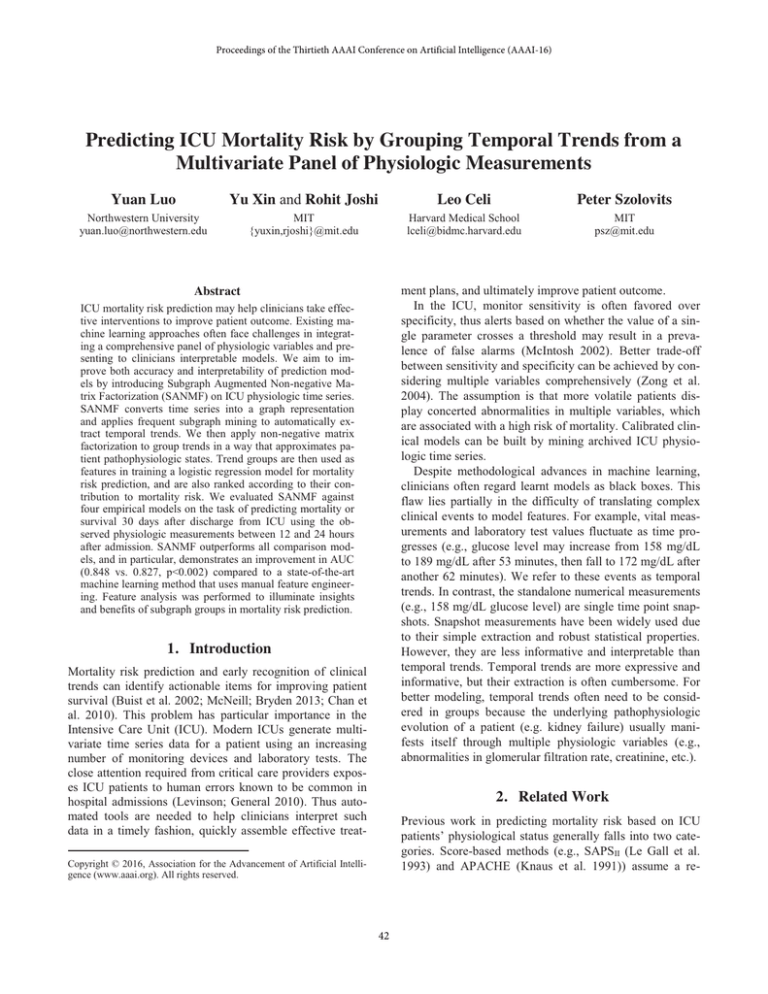
Proceedings of the Thirtieth AAAI Conference on Artificial Intelligence (AAAI-16)
Predicting ICU Mortality Risk by Grouping Temporal Trends from a
Multivariate Panel of Physiologic Measurements
Yuan Luo
Yu Xin and Rohit Joshi
Leo Celi
Peter Szolovits
Northwestern University
yuan.luo@northwestern.edu
MIT
{yuxin,rjoshi}@mit.edu
Harvard Medical School
lceli@bidmc.harvard.edu
MIT
psz@mit.edu
ment plans, and ultimately improve patient outcome.
In the ICU, monitor sensitivity is often favored over
specificity, thus alerts based on whether the value of a single parameter crosses a threshold may result in a prevalence of false alarms (McIntosh 2002). Better trade-off
between sensitivity and specificity can be achieved by considering multiple variables comprehensively (Zong et al.
2004). The assumption is that more volatile patients display concerted abnormalities in multiple variables, which
are associated with a high risk of mortality. Calibrated clinical models can be built by mining archived ICU physiologic time series.
Despite methodological advances in machine learning,
clinicians often regard learnt models as black boxes. This
flaw lies partially in the difficulty of translating complex
clinical events to model features. For example, vital measurements and laboratory test values fluctuate as time progresses (e.g., glucose level may increase from 158 mg/dL
to 189 mg/dL after 53 minutes, then fall to 172 mg/dL after
another 62 minutes). We refer to these events as temporal
trends. In contrast, the standalone numerical measurements
(e.g., 158 mg/dL glucose level) are single time point snapshots. Snapshot measurements have been widely used due
to their simple extraction and robust statistical properties.
However, they are less informative and interpretable than
temporal trends. Temporal trends are more expressive and
informative, but their extraction is often cumbersome. For
better modeling, temporal trends often need to be considered in groups because the underlying pathophysiologic
evolution of a patient (e.g. kidney failure) usually manifests itself through multiple physiologic variables (e.g.,
abnormalities in glomerular filtration rate, creatinine, etc.).
Abstract
ICU mortality risk prediction may help clinicians take effective interventions to improve patient outcome. Existing machine learning approaches often face challenges in integrating a comprehensive panel of physiologic variables and presenting to clinicians interpretable models. We aim to improve both accuracy and interpretability of prediction models by introducing Subgraph Augmented Non-negative Matrix Factorization (SANMF) on ICU physiologic time series.
SANMF converts time series into a graph representation
and applies frequent subgraph mining to automatically extract temporal trends. We then apply non-negative matrix
factorization to group trends in a way that approximates patient pathophysiologic states. Trend groups are then used as
features in training a logistic regression model for mortality
risk prediction, and are also ranked according to their contribution to mortality risk. We evaluated SANMF against
four empirical models on the task of predicting mortality or
survival 30 days after discharge from ICU using the observed physiologic measurements between 12 and 24 hours
after admission. SANMF outperforms all comparison models, and in particular, demonstrates an improvement in AUC
(0.848 vs. 0.827, p<0.002) compared to a state-of-the-art
machine learning method that uses manual feature engineering. Feature analysis was performed to illuminate insights
and benefits of subgraph groups in mortality risk prediction.
1. Introduction
Mortality risk prediction and early recognition of clinical
trends can identify actionable items for improving patient
survival (Buist et al. 2002; McNeill; Bryden 2013; Chan et
al. 2010). This problem has particular importance in the
Intensive Care Unit (ICU). Modern ICUs generate multivariate time series data for a patient using an increasing
number of monitoring devices and laboratory tests. The
close attention required from critical care providers exposes ICU patients to human errors known to be common in
hospital admissions (Levinson; General 2010). Thus automated tools are needed to help clinicians interpret such
data in a timely fashion, quickly assemble effective treat-
2. Related Work
Previous work in predicting mortality risk based on ICU
patients’ physiological status generally falls into two categories. Score-based methods (e.g., SAPSII (Le Gall et al.
1993) and APACHE (Knaus et al. 1991)) assume a re-
Copyright © 2016, Association for the Advancement of Artificial Intelligence (www.aaai.org). All rights reserved.
42
source-limited ICU setting and aim to select a limited set
of commonly measured clinical predictors that can (often
manually) be aggregated into a severity score and best associated to a particular outcome. Others adopt a broader
modeling perspective. Hug et al. (Hug; Szolovits 2009)
considered a comprehensive set of physiologic measurements from the Multiparameter Intelligent Monitoring in
Intensive Care (MIMIC-II) clinical dataset (Saeed et al.
2011) and manually defined a set of trend patterns. Quinn
et al. (Quinn et al. 2009) developed a factorial switching
linear dynamic system to model the patient states underlying 8 physiologic measurements. Cohen et al. (Cohen et al.
2010) used hierarchical clustering to extract 10 clusters as
clinically relevant patient states from physiologic measurements, over a set of 17 patients and 14 measurements.
However, these methods either model temporal trends independently without capturing correlated trends manifesting underlying pathophysiologic states, or lack scalability
to many more physiologic variables. Recently, the 2012
PhysioNet/Computing in Cardiology Challenge tackled the
problem of in-hospital mortality prediction on MICMIC-II
dataset with 36 physiologic time series from first 2 days of
admission (Silva et al. 2012; Johnson et al. 2012; Lee et al.
2012; Citi; Barbieri 2012; Xia et al. 2012; McMillan et al.
2012; Vairavan et al. 2012; Krajnak et al. 2012; Severeyn
et al. 2012; Pollard et al. 2012; Hamilton; Hamilton 2012;
Bera; Nayak 2012). The challenge used the minimum of
precision and recall (score1) as official evaluation metrics
with highest score1 around 0.53. Several systems also reported AUC scores from 0.82 (e.g., (McMillan et al. 2012),
score1=0.46) to 0.86 (e.g., (Johnson et al. 2012),
score1=0.53). Joshi et al. (Joshi; Szolovits 2012) extended
to 54 physiologic time series to predict 30-day mortality
for ICU patients. They manually clustered the physiologic
measurements into organ specific patient states by associating each measurement with the status of a particular organ, and achieved a state-of-the-art 30-day mortality AUC
of 0.91 on the MIMIC-II dataset. Despite improving scalability, their manual feature clustering applies to only snapshot measurements and can be a subjective call. For example, low hematocrit may be linked to blood loss, bone marrow problems or kidney problems, thus is hard to assign to
a specific organ. Addressing these challenges, we study
how to group temporal trends instead of single time point
measurements, and how evidence-based grouping can be
performed over a comprehensive set of physiologic variables. Our representation of temporal trends falls into the
category of time series abstraction that discretizes time
series into sequences of symbols and attaches meaning to
the symbols (Lin et al. 2007; Dagliati et al. 2014; Combi et
al. 2012; Moskovitch; Shahar 2014; Sacchi et al. 2015).
We chose our discretization approach to be consistent with
the state-of-the-art comparison model (Joshi; Szolovits
2012), which showed that a customized z-score was an
effective discretization on MIMIC-II data. Our approach
also handles time series with irregularly sampled time
points, though we expect augmenting it with some of the
above abstraction methods may lead to further improvements and leave this as future work.
3. Methods
In this work, we develop an unsupervised feature learning
method in order to build machine learning models that are
both more accurate and more interpretable to clinicians.
The model applies non-negative matrix factorization to
discover groups of subgraph-encoded temporal progression
trends, hence the name Subgraph Augmented Nonnegative Matrix Factorization (SANMF).
3.1 Workflow of SANMF
We first outline the workflow of the SANMF algorithm in
Fig 1. ICU physiologic time series are first converted to
graph representations. The graph representation is derived
by discretizing time and measurement axes for physiologic
measurements. We use a frequent subgraph mining tool to
collect important subgraphs where the subgraphs are identified as common temporal trends of the physiologic variables. With such representations, subgraphs encode temporal trends, and we use “subgraphs” and “temporal
trends” interchangeably within the context of this paper.
We model the correlation between the subgraphs, and apply non-negative matrix factorization to discover groups of
subgraphs and patients, and then train a logistic regression
model to predict the mortality risk using subgraph groups
as features. We next explain each step in more detail.
3.2 Representing Time Series as Graphs
In representing the time series as graphs, we focus on the
data from the second half of the first day after patients’
admissions to ICU. We exclude the first half of the first
day because many measurements are not yet available in
that time period. The time series of different variables are
often sparse and irregularly sampled, and contaminated by
a variety of noise and human error. Thus before converting
time series into graphs, we perform discretization on both
the time axis and the measurement axis. We discretize the
time axis by linearly interpolating the time series and resampling at regularly spaced time intervals. We expect
more advanced imputation algorithms such as EM or
Gaussian processes inference may lead to better performance at the expense of more parameter tuning and leave
these to future work. We determined empirically (by 5-fold
cross-validation over choices of 1, 2, 4, or 6 hour intervals)
that a two-hour time interval was best in our experiment.
With the interpolated time series, we compute a customized z-score (z’-score) where we define measurements
43
within the reference range of a certain test to be 0. For a
physiologic variable ݔ, let ݔ and ݔ be the low and high
ends of the reference range, let ݆ index different ICU patient stays, and ߤሺݔሻ and ߪሺݔሻ be the mean and standard
deviation of variable ݔacross different ICU patient stays,
the z’-score is calculated using the following equations
ݖ൫ݔ ൯ ൌ ቀݔ െ ߤሺݔሻቁ Ȁߪሺݔሻ
tion, we generate the time series graph for each measurement by connecting the discretized measurement values
that are adjacent on the time axis. We use three types of
edges to distinguish changes between adjacent nodes,
namely up, down and same, and to encode partial directionality in temporal progression.
(1)
3.3 Frequent Subgraph Mining
Frequent subgraph mining (FSM) is a technique for pattern
mining and has seen applications in natural language processing (Luo et al. 2014; Luo et al. 2015; Liu et al. 2013).
In this work, we adapt FSM to produce the temporal trends
that are common in the dataset. Intuitively, similar patients
undergo similar physiologic trajectories during their ICU
stays. Compared to temporal pattern mining (e,g, motif
mining in (McMillan et al. 2012) and temporal variation
summarization in (Hug; Szolovits 2009)), FSM supports
flexible sequence/graph size and frequency based selection. FSM is defined on the notion of graph subisomorphism. We say one graph ܩ௦ is subisomorphic to another
graph ܩif all its nodes ܸ௦ and edges ܧ௦ match with part of
the other one. A subgraph occurs once in a corpus whenever it is subisomorphic to a graph in that corpus. Frequent
subgraph mining identifies those subgraphs whose occurrences in a corpus are above a given threshold. In this
work, we use the frequent subgraph miner MoSS (Borgelt;
Berthold 2002) with frequency threshold empirically chosen (by 5-fold cross-validation on choices including 5, 10
or 15) to be 10 (i.e., subgraphs must occur at least ͳͲ times
in the dataset). Example frequent subgraphs are shown in
Fig 3. The frequent subgraph mining step takes 1 min on a
2.7GHz CPU 8GB RAM laptop and generates 5534 frequent subgraphs. Among them, smaller subgraphs may be
subisomorphic to other larger frequent subgraphs. When a
larger subgraph is frequent; all of its subgraphs are necessarily also frequent. Furthermore, if a patient case has a
larger subgraph, then both the larger and smaller subgraphs
are counted for that patient. This may cause the signal from
larger subgraphs to be overwhelmed by the signal from
many smaller subgraphs. Therefore, we kept only the larger subgraphs in such pairs when a patient case has both.
Note that such filtering is different from the notion of mining maximal frequent subgraphs, where only subgraphs
that are not a part of any other frequent subgraphs at all are
collected (Huan et al. 2004). It is cost prohibitive to perform a full pairwise check because the subisomorphism
comparison between two subgraphs is already NPcomplete (Nijssen; Kok 2005), and a pairwise approach
would ask for over 15 million such comparisons for our
task. However, in our case, we only need to compare subgraph pairs from the same physiologic variable. Furthermore, subgraph subisomorphism comparison can be simplified into string matching because our subgraphs are essentially sequences of maximum length 6. Combining the
two observations, the algorithm for determining the
݂݅ݖሺݔ ሻ ൏ ݖ൫ݔ ൯ ൏ ݖሺݔ ሻ
Ͳ
ݖԢሺݔ ሻ ൌ ൞ݖ൫ݔ ൯ െ ݖሺݔ ሻ
݂݅ݖ൫ݔ ൯ ݖሺݔ ሻ
ݖ൫ݔ ൯ െ ݖሺݔ ሻ
݂݅ݖ൫ݔ ൯ ൏ ݖሺݔ ሻ
(2)
Computing z’
… … … !"
!
%
$&
!#$
'&(
".
)&(
"
)&(
*
+
!",
!
"
",
-
"
Fig 1 Workflow of SANMF. We focus on the physiologic time
series from the second half of the first day in ICU admission,
balancing the trade-off between early detection of clinical trends
and data availability. In the flow chart, shaded blocks indicate
comparison models, see section 2 for organ level summarization,
section 3.2 for D,I-measure, section 3.3 for subgraphs. The block
with bold fonts corresponds to the features output by SANMF.
Interpolating-then-normalizing aims to address the sampling bias that normal physiologic variables are sampled
less frequently (email correspondence with MIMIC-II curators). Admittedly, interpolations are not real measurements, but they are reasonable estimates to counterbalance
sampling bias, as ICU monitoring should catch most sudden/drastic changes. Each individual measurement is then
discretized based on whether its value is within the reference range (label 0), within one ߪ outside the reference
range (label േ1), or beyond one ߪ outside the reference
range (label േ 2). Such discretization is essentially a
thresholded round-up from equation ( 2 ). After discretiza-
44
subisomorphism relation among frequent subgraphs is
shown in Fig 2. The above filtering step takes 0.5 min and
in fact does exclude some small subgraphs completely,
leaving the final number of subgraphs at 5387.
(Lin 2007) implemented in Scikit-learn (Pedregosa et al.
2011). We use nonnegative double singular value decomposition as a deterministic initialization method (Boutsidis;
Gallopoulos 2008). We also enforce sparsity on subgraph
groups (Hoyer 2004) so that a group has only a limited
number of non-zero weighted subgraphs and places most
weight on only a few subgraphs, which is easier to interpret for clinicians.
–
–
ܵ௩ !
"ܵ௩ #$
%!&
"ܵ௩ #
'
!ܵ௩ ()**
+!ܵ௩ ()**
,
"(
)-()#
.(
-)!
/
3.5 Feature Group Discovery Using SANMF
In SANMF, the column vectors in the subgraph factor matrix ܸ specify the grouping of subgraphs. Such groupings
can be viewed as mixtures of subgraphs, as they allow
sharing of a subgraph among different groups as specified
by its fractional weights across groups. In Fig 3 two example subgraph groups are shown. The top ranked subgraphs
in subgraph group 1 indicate a general progression to an
improved state. The top ranked subgraphs in subgraph
group 2 indicate a general progression to a worse state. The
motivation is to identify some subgraph groups that can
indicate concerted progression patterns of physiologic variables as driven by the patient’s underlying pathophysiologic evolution. The subgraph groups as specified in ܸ are
used as features in logistic regression with the instancefeature matrix being ܷ. Using the trained regression model,
we rank the subgraph groups by their regression coefficients and focus on the top subgraph groups that are associated with high mortality risk.
Fig 2 Algorithm for determining subisomorphism relation among
time series subgraphs. The simplification mainly comes from
variable partition (line 1-2) and reduction of subisomorphism to
substring match (line 8) for time series subgraphs.
3.4 Subgraph Augmented NMF
Non-negative Matrix Factorization (NMF) has been a highly effective unsupervised method to cluster similar patients
(Hofree et al. 2013) and sample cell lines (Müller et al.
2008), and to identify subtypes of diseases (Collisson et al.
2011). We explore a novel application of NMF based on
the observation that a patient’s underlying pathophysiologic evolution usually manifests itself in a group of temporal
progression trends concerning multiple physiologic variables. This motivates us to use NMF to group time series
subgraphs by factorizing the patient-by-subgraph count
matrix, hence the name Subgraph Augmented NMF
(SANMF). A schematic view of SANMF is shown in Fig
3. Let ܯbe the patient-by-subgraph count matrix of dimension ܲ ൈ ܵ, where ܲ is the number of patients and ܵ is
the number of subgraphs. NMF approximates ܯusing two
lower ranked matrices ܷ (of dimension ܲ ൈ ܵ where ܵ is
the number of subgraph groups) and ܸ (of dimension ܵ ൈ
ܵ), as formalized in the following equation.
݉݅݊ԡ ܯെ ܷܸԡଶி
ǡ
ݐݏǤ ܷ Ͳǡ ܸ Ͳ
3.6 Evaluating the Groups Discovered by SANMF
Because there is no innate way to determine whether the
groupings of subgraphs discovered by SANMF are good or
poor, we evaluate their utility as features, abstracted from
the base data, in a prediction model. We assume that good
features will improve prediction and will give us some
insights into which temporal trend patterns are indicative
of patient mortality risk. We use physiologic time series
from the MIMIC-II database (Saeed et al. 2011). The time
series include laboratory test values and physiologic measurements captured from patients monitored in the ICU at
Beth-Israel Deaconess Medical Center (BIDMC) (see appendix A-Table 1 for a list of variables and their interpretation). Our dataset is a subset of the one used by Joshi et al.
(Joshi; Szolovits 2012) (patients from the year 2000 to
2008); we only include those patients who have at least one
day length of time series data. We predict whether a patient
survives or dies in the ICU or within 30 days after ICU
discharge, from data available for each patient during the
period between 12 and 24 hours after their admission to the
ICU. Choosing the 30-day mortality instead of in-hospital
mortality emphasizes our motivation to detect clinical
trends early on. We partitioned the cases equally, stratified
by mortality, into a training set (3932 cases total) and a test
set (3931 cases total), as shown in Table 1.
(3)
where ԡڄԡଶி indicates squared Frobenius norm (squared
summation of all entries in a matrix) and ܷ Ͳ means that
ܷ is entry-wise non-negative. Intuitively, each row of ܸ
gives the composition of each subgraph group, each column of ܷ reveals how each patient may be viewed as having a mixture of subgraph groups (approximating pathophysiologic evolutions).
As we are focusing on count data that is by definition
nonnegative, we use NMF instead of other grouping methods such as k-means or principal component analysis
(PCA) that do not have a built-in nonnegative constraint.
The NMF solver we used is the projected gradient NMF
45
Trend Group 1
2
2
3
4
2
3
4
3
3
3
3
2
2
2
2
2
2
3
3
3
3
3
3
2
3
2
3
3
3
&
/6
*5
2
… … … ...
/0*1
*6
Patients
/0*1
*6
3
*5
/0*1
2
x
3
3
4
3
3
3
3
3
3
2
2
2
2
2
2
3
3
3
3
3 3
… … … ...
2
3
&
/6
… … … ...
Trend Group 2
3 3
*5
/0*1
x
2
Trend Groups
x
2
*5 2
Patient Groups
Temporal Trends
(Subgraphs)
2
4
Fig 3 Subgraph Augmented Non-negative Matrix Factorization model. In the figure, ܯis the patient-by-subgraph count matrix. Next to it
are some example subgraph (trends). We also show example trend group 1 and trend group 2 after factorization. It is often desirable to
have some trend groups indicate a general progression to the better states (e.g., trend group 1), or to the worse states (e.g., trend group 2).
Patient ICU Stays
Mortality
Total Cases
Training Cases
30 days
788
383 (9.7%)
405 (10.3%)
7075
3549 (90.3%)
3526 (89.7%)
30 days or alive
Test Cases
4. Results
4.1 Performance on ICU Mortality Prediction
When using NMF to identify latent groups of temporal
trend features, the number of groups needs to be empirically determined. We set this parameter to 100 by 5-fold
cross-validation on the training data and considered a range
of groups between 10 and 120 (at increments of 10), see
appendix A-Fig 1 for detail. NMF with 100 groups takes
12 min in total for training and test data on a 2.7GHz CPU
8GB RAM laptop.
The AUC performance results of SANMF, comparison
models and the baseline on held-out test data are shown in
Fig 4. Comparing all the models and baseline, we can see
that SAPSII approximation has an AUC of 0.673, which is
lower than what is generally reported for SAPSII in the
literature (Le Gall et al. 1993; Hug; Szolovits 2009; Joshi;
Szolovits 2012) (We address this issue in detail in the Discussion). Nevertheless, all models that abstract the measured data by discretizing and aggregating them perform
better by a large margin, each with an AUC greater than
0.8. The predictive model based on our SANMF-derived
trend groups has the best performance, with an AUC of
0.848, significantly better (p<0.002 by random permutation
test (Noreen 1989)) than the next-best model (AUC=0.827)
based on abstraction by organ-system.
Table 1. Statistics of experiment data. The table includes the ICU
patients’ 30-day mortality distribution. The dataset is split equally into a training set and a test set.
To evaluate the effectiveness of SANMF in abstracting
raw data into more predictive features, we use 5-fold crossvalidation on the training set to choose the number of subgraph groups, and use these subgraph groups as independent features to train a logistic regression model. We chose
logistic regression over alternatives such as SVM or random forests for its capability to generate deterministic
weights for individual features. As we have already
grouped the subgraphs by accounting for their correlations,
logistic regression provides a convenient way to directly
assess subgraph group contribution. We then evaluate the
model on the held-out test cases, and compare its performance against the following models: (a) as a baseline, 30day mortality prediction by a logistic regression model
using an approximation of the SAPSII score and its logarithm as predictors, where the SAPS II variable “chronic
diseases” is approximated using ICD9 codes and the variable “type of admission” is approximated using the ICU
service type (Hug; Szolovits 2009); (b) a state-of-the-art
organ-level summarization model (Joshi; Szolovits 2012)
for which we obtained their code and adapted it to account
for our use of 12 hours of data rather than snapshot measurements by replacing the binary representation of whether
an organ system is in a specific state with the number of
times it is in that state during the 12 hours; (c) the D,Imeasure based on our discretized (D) and interpolated (I)
data values, where we also count the number of times each
physiologic variable took on a discretized value during the
12 hours; and (d) a model based on treating subgraphs as
independent features. The comparison models (b-d) are
shaded in Fig 1. We compare the Area Under the ROC
Curve (AUC) of our model against these four others.
4.2 Important Subgraph Groups
Using the method in the feature group discovery section,
we identified the top two subgraph groups that are associated with high mortality risk as listed in Table 2. These
subgraph groups typically contain physiologic trends that
stay at constant discretized values or sometimes progress to
more severe states. In addition, they collectively indicate
problematic pathophysiologic processes that involve one
organ or multiple organs simultaneously, while still retaining the temporal trend details at the physiologic variable
level.
For example, the first associated subgraph group has
46
several subgraphs suggesting that the patient mainly has
pulmonary problems (continuously low minute ventilation,
high plateau pressure, fluctuating airway resistance, and
high level of positive end-expiratory pressure set on the
ventilator). On the other hand, this group also has Glasgow
Coma Scale staying very low, meaning that the patient is
probably unconscious or sedated. Thus this group may be
interpreted as unconscious or sedated patients with severe
pulmonary problems. The second associated subgraph
group displays abnormal trends related to problems in multiple organs including kidney, lung, and heart.
system by (Joshi; Szolovits 2012) adapted to use 12hr data
(Fig 4 organ model). Their AUC drop from 0.91 to 0.827 is
consistent with using less data (totality vs. 12hr). In addition, both 0.848 and 0.827 30-day mortality AUCs are inferior to those for in-hospital mortality prediction (e.g.,
AUC=0.86, (Johnson et al. 2012) from PhysioNet/CinC2012), highlighting that 30-day mortality prediction is a more difficult task. Note that we combined perspectives from previous studies by reducing 48hr data in
Physionet/CinC2012 to 12hr and predicting 30-day mortality. Although both extensions increase task difficulty, they
offer potential clinical value as observed separately by previous studies.
30-day Mortality 1st Subgraph Group
0.1000 Glasgow Coma Scale
-2 -2 -2 -2 -2 -2
0.0085 Minute Ventilation
-2 -2 -2 -2 -2 -2
0.0082 Minute Ventilation
-1 -1 -1 -1 -1 -1
0.0081 PEEPSet
222222
0.0066 Airway Resistance
10
0.0060 Airway Resistance
011
0.0059 Plateau Pressure
222222
0.0052 PEEPSet
111111
0.0047 PaO2/FiO2
02
0.0040 Airway Resistance
110
30-day Mortality 2nd Subgraph Group
0.1634 BUN/Creatinine
222222
0.0481 BUN
222222
0.0155 Albumin
-2 -2 -2 -2 -2 -2
0.0040 Arterial CO2
111111
0.0040 Heart Rate
0 -1
0.0038 Na
222222
0.0034 Na
11111
0.0033 Arterial CO2
22222
0.0032 Arterial Base Excess
21
0.0029 Delivered Tidal Volume -1 -1 -1 0
Fig 4 ROC curves for proposed method SANMF, comparison
models including subgraphs as independent features, discretized
& interpolated measures (D,I-measure), and organ level status,
as well as the baseline model using SAPSII approximation.
SANMF significantly outperforms the next-best model (AUC
0.848 vs 0.827, p<0.002).
An interesting observation is that top ranked subgraph
groups contributing to high mortality risk usually involve
problems in multiple organs rather than a single organ,
which is more likely to happen in real ICU settings. Such
grouping is difficult to achieve using manual grouping
according to only organ status as done by Joshi et al.
(Joshi; Szolovits 2012) and is considered one of the benefits of using NMF to automatically group temporal progression trends in an evidence-driven fashion.
5. Limitation, Discussion and Future Work
Table 2 Top trend groups associated with high mortality risks.
Trends are converted into a sequence to save space. For each
trend such as “0.1000 Glasgow Coma Scale -2 -2 -2 -2 -2 -2”,
0.1000 is the membership coefficient, Glasgow Coma Scale is the
measurement label, “-2 -2 -2 -2 -2 -2” is the trend (flat for this
case). Abbreviations used in the table include: PEEPSet – positive end-expiratory pressure set on ventilator; PaO2 – arterial
oxygen tension; FiO2 – fraction of inspired oxygen; BUN – blood
urea nitrogen; Na – sodium level. Please refer to appendix ATable 1 for the detailed description and interpretation of all the
variables.
We observe that the AUC for our approximation to SAPSII
is lower than in previously reported studies (Le Gall et al.
1993; Hug; Szolovits 2009; Joshi; Szolovits 2012). We
believe that this is due to the large amount of missing data
in our data set and the approximations we make because
our data do not include the exact parameters used in
SAPSII. Moreover, we built SAPSII predictions on 12hr
data and obtained a 30-day mortality AUC=0.67, whereas
(Joshi; Szolovits 2012) used all the data and reported an
AUC=0.77 by SAPSII. Putting system performance into
context, our system outperforms (AUC 0.848 vs. 0.827) the
In this work, we use 30-day mortality (including mortality in hospital or within 30 days after discharge) as an
obtainable ground truth in order to demonstrate the efficacy of SANMF as an unsupervised feature learning algorithm. Similar methods may be applicable to improve not
only mortality predictions but also predictions that indicate
specific types of patient deterioration (e.g., anticipating
hypotension, kidney injury, hepatic failure, sepsis) and
identifying therapeutic opportunities (e.g., ability to wean
from a ventilator, an intra-aortic balloon pump, vasopressors). Such improved models can provide decision support
47
for treatment planning and informed staffing. A systematic
comparison of published systems, for both mortality and
customized outcome prediction, along the directions of
both FSM and temporal pattern methods (Hug; Szolovits
2009; McMillan et al. 2012), can be informative to the research community and is part of our future work.
In our experiment, FSM takes 1.5 min and NMF takes
12 min on a 2.7GHz CPU 8GB RAM laptop. NMF is most
time consuming but necessary for better interpretability
and accuracy, as demonstrated by Fig 4 and Table 2. Note
that we only included physiologic time series, in order to
make a fair comparison to the baseline model SAPS II, and
did not include treatment. However, ICU mortality risk can
be better stratified by considering the interplay between
observations and interventions. In addition, we want to
further model trend-intervention and trend-trend relative
changes such as “if temperature rose before the change in
BUN”. Capturing both aspects may require interconnecting
trend and intervention sequences, thus generating proper
graphs and subgraphs. The intention to pursue this direction motivated us to resort to the reasonably fast subgraph
mining instead of sequence mining in the first place. We
expect further improved accuracy and interpretability by
predicting outcomes for patient groups who have similar
underlying pathophysiologic evolutions and who have undergone similar treatment regimens. This step asks for better heuristics in FSM and our subgraph subisomorphism
check, and perhaps more refined discretization and interpolation, but is a promising direction.
Acknowledgements
The work described was supported in part by Grant Number U54LM008748 from the National Library of Medicine.
The intensive care data are from a data set distributed under a limited data use agreement, which was approved by
the Beth Israel Deaconess Hospital’s IRB.
References
Bera, D.; Nayak, M.M., 2012. Mortality risk assessment for ICU
patients using logistic regression. In Computing in Cardiology
(CinC). 493–496, IEEE.
Borgelt, C.; Berthold, M.R., 2002. Mining molecular fragments:
Finding relevant substructures of molecules. In Proceedings. 2002
IEEE International Conference on Data Mining. 51–58, IEEE.
Boutsidis, C.; Gallopoulos, E., 2008. SVD based initialization: A
head start for nonnegative matrix factorization. Pattern Recognition 41(4): 1350–1362.
Buist, M.D. et al., 2002. Effects of a medical emergency team on
reduction of incidence of and mortality from unexpected cardiac
arrests in hospital: preliminary study. BMJ 324(7334): 387–390.
Chan, P.S. et al., 2010. Rapid response teams: a systematic review and meta-analysis. Archives of internal medicine 170(1):
18–26.
Citi, L.; Barbieri, R., 2012. PhysioNet 2012 Challenge: Predicting
mortality of ICU patients using a cascaded SVM-GLM paradigm.
In Computing in Cardiology (CinC). 257–260, IEEE.
Cohen, M.J. et al., 2010. Research Identification of complex metabolic states in critically injured patients using bioinformatic
cluster analysis. Critical Care 14(1): R10.
Collisson, E.A. et al., 2011. Subtypes of pancreatic ductal adenocarcinoma and their differing responses to therapy. Nature medicine 17(4): 500–503.
Combi, C.; Pozzi, G.; Rossato, R., 2012. Querying temporal clinical databases on granular trends. Journal of biomedical informatics 45(2): 273–291.
Dagliati, A. et al., 2014. Temporal data mining and process mining techniques to identify cardiovascular risk-associated clinical
pathways in Type 2 diabetes patients. In Biomedical and Health
Informatics (BHI), 2014 IEEE-EMBS International Conference
on. 240–243, IEEE.
Le Gall, J.-R.; Lemeshow, S.; Saulnier, F., 1993. A new simplified acute physiology score (SAPS II) based on a European/North
American multicenter study. JAMA: the journal of the American
Medical Association 270(24): 2957–2963.
Hamilton, S.L.; Hamilton, J.R., 2012. Predicting in-hospital-death
and mortality percentage using logistic regression. In Computing
in Cardiology (CinC). 489–492, IEEE.
Hofree, M. et al., 2013. Network-based stratification of tumor
mutations. Nature methods 10(11): 1108–1115.
Hoyer, P.O., 2004. Non-negative matrix factorization with
sparseness constraints. The Journal of Machine Learning Research 5: 1457–1469.
Huan, J. et al., 2004. Spin: mining maximal frequent subgraphs
from graph databases. In Proceedings of the tenth ACM SIGKDD
international conference on Knowledge discovery and data mining. 581–586, ACM.
6. Conclusions
We proposed a novel unsupervised feature learning algorithm named Subgraph Augmented Non-negative Matrix
Factorization (SANMF), designed for analyzing temporal
progression patterns in clinical time series, and showed it
to improve both the accuracy and the interpretability of the
learnt model for ICU mortality risk prediction. In summary, subgraph mining on multivariate time series leads to
unsupervised extraction of multivariate temporal trends,
which are more informative than snapshot measurements.
The ensuing NMF-based step groups correlated temporal
trends of different physiologic variables. This leads to better interpretability and improved accuracy. We compared
SANMF with four different models using features with
varying granularities and time spans. SANMF outperforms
all the comparison models and in particular demonstrates
an AUC improvement from 0.827 to 0.848 (p < 0.002),
compared to a similarly motivated state-of-the-art model
on MIMIC-II dataset that explores manual feature engineering. A detailed feature analysis of the subgraph groups
that are generated by SANMF offers more clinical insights
about multiple organ problems associated with high mortality risk, all being automatically identified from the data.
48
Hug, C.W.; Szolovits, P., 2009. ICU acuity: real-time models
versus daily models. In AMIA Annual Symposium Proceedings.
260–264, American Medical Informatics Association.
Johnson, A.E. et al., 2012. Patient specific predictions in the intensive care unit using a Bayesian ensemble. In Computing in
Cardiology (CinC). 249–252, IEEE.
Joshi, R.; Szolovits, P., 2012. Prognostic Physiology: Modeling
Patient Severity in Intensive Care Units Using Radial Domain
Folding. In AMIA Annual Symposium Proceedings. 1276–1283,
American Medical Informatics Association.
Knaus, W.A. et al., 1991. The APACHE III prognostic system.
Risk prediction of hospital mortality for critically ill hospitalized
adults. CHEST Journal 100(6): 1619–1636.
Krajnak, M. et al., 2012. Combining machine learning and clinical rules to build an algorithm for predicting ICU mortality risk.
In Computing in Cardiology (CinC). 401–404, IEEE.
Lee, C.H. et al., 2012. An imputation-enhanced algorithm for
ICU mortality prediction. In Computing in Cardiology (CinC).
253–256, IEEE.
Levinson, D.R.; General, I., 2010. Adverse events in hospitals:
national incidence among Medicare beneficiaries. Department of
Health and Human Services Office of the Inspector General.
Lin, C.-J., 2007. Projected gradient methods for nonnegative
matrix factorization. Neural computation 19(10): 2756–2779.
Lin, J. et al., 2007. Experiencing SAX: a novel symbolic representation of time series. Data Mining and knowledge discovery
15(2): 107–144.
Liu, H. et al., 2013. Approximate Subgraph Matching-Based
Literature Mining for Biomedical Events and Relations. PloS one
8(4): e60954.
Luo, Y. et al., 2014. Automatic Lymphoma Classification with
Sentence Subgraph Mining from Pathology Reports. Journal of
the American Medical Informatics Association (JAMIA) 2014
21(5): 824–832.
Luo, Y. et al., 2015. Subgraph Augmented Non-Negative Tensor
Factorization (SANTF) for Modeling Clinical Text. Journal of the
American Medical Informatics Association ocv016.
McIntosh, N., 2002. Intensive care monitoring: past, present and
future. Clinical medicine 2(4): 349–355.
McMillan, S. et al., 2012. ICU mortality prediction using time
series motifs. In Computing in Cardiology (CinC). 265–268,
IEEE.
McNeill, G.; Bryden, D., 2013. Do either early warning systems
or emergency response teams improve hospital patient survival?
A systematic review. Resuscitation 84(12): 1652–1667.
Moskovitch, R.; Shahar, Y., 2014. Classification of multivariate
time series via temporal abstraction and time intervals mining.
Knowledge and Information Systems 1–40.
Müller, F.-J. et al., 2008. Regulatory networks define phenotypic
classes of human stem cell lines. Nature 455(7211): 401–405.
Nijssen, S.; Kok, J.N., 2005. The gaston tool for frequent subgraph mining. Electronic Notes in Theoretical Computer Science
127(1): 77–87.
Noreen, E.W., 1989. Computer-intensive methods for testing
hypotheses: an introduction, Wiley.
Pedregosa, F. et al., 2011. Scikit-learn: Machine learning in Python. The Journal of Machine Learning Research 12: 2825–2830.
Pollard, T.J. et al., 2012. 2012 PhysioNet Challenge: An artificial
neural network to predict mortality in ICU patients and application of solar physics analysis methods. In Computing in Cardiology (CinC). 485–488, IEEE.
Quinn, J.A.; Williams, C.K.; McIntosh, N., 2009. Factorial
switching linear dynamical systems applied to physiological condition monitoring. Pattern Analysis and Machine Intelligence,
IEEE Transactions on 31(9): 1537–1551.
Sacchi, L.; Dagliati, A.; Bellazzi, R., 2015. Analyzing Complex
Patients’ Temporal Histories: New Frontiers in Temporal Data
Mining. In Data Mining in Clinical Medicine. 89–105, Springer.
Saeed, M. et al., 2011. Multiparameter Intelligent Monitoring in
Intensive Care II (MIMIC-II): a public-access intensive care unit
database. Critical care medicine 39(5): 952–960.
Severeyn, E. et al., 2012. Towards the prediction of mortality in
Intensive Care Units patients: A Simple Correspondence Analysis
approach. In Computing in Cardiology (CinC). 469–472, IEEE.
Silva, I. et al., 2012. Predicting in-hospital mortality of ICU patients: The physioNet/computing in cardiology challenge 2012. In
Computing in Cardiology (CinC). 245–248, IEEE.
Vairavan, S. et al., 2012. Prediction of mortality in an intensive
care unit using logistic regression and a hidden Markov model. In
Computing in Cardiology (CinC). 393–396, IEEE.
Xia, H. et al., 2012. A neural network model for mortality prediction in ICU. In Computing in Cardiology (CinC). 261–264, IEEE.
Zong, W.; Moody, G.; Mark, R., 2004. Reduction of false arterial
blood pressure alarms using signal quality assessement and relationships between the electrocardiogram and arterial blood pressure. Medical and Biological Engineering and Computing 42(5):
698–706.
49
Appendix
Variable
Description
Variable
Description
Age
Hemoglobin
Albumin
ALT
Arterial Base Excess
Arterial CO2
Arterial PaCO2
Age of the patient upon admission
The resistance of the respiratory tract to airflow during inspiration and expiration.
Albumin in blood
Alanine aminotransferase in blood
Excess in the amount of base present in arterial blood
Arterial carbon dioxide
Arterial carbon dioxide tension
Ion Calcium
K
Lactate
MAP
Mg
Arterial PaO2
Arterial oxygen tension
Minute Ventilation
Arterial pH
pH level in arterial blood
Na
AST
Aspartate aminotransferase in blood
PaO2/FiO2
AST/ALT
Aspartate aminotransferase / alanine aminotransferase PTT
BUN
Blood urea nitrogen
PEEPSet
BUN/Creatinine
Blood urea nitrogen / Creatinine
PIP
Ca
Calcium level
Plateau Pressure
Hemoglobin level
Prothrombin time international
normalized ratio
Ion Calcium level
Potassium level
Lactate level
Mean arterial pressure
Magnesium level
Volume of gas exchanged from lung
per minute
Sodium level
Partial pressure arterial oxygen /
Fraction of inspired oxygen
Partial Thromboplastin Time
Positive end-expiratory pressure set
on ventilator
Peak inspiratory pressure
Pressure applied (in positive pressure ventilation) to the small airways and alveoli
Cardiac Index
Relates the cardiac output (CO) from left ventricle in
Platelets
one minute to body surface area
Platelets count
Blood pressure in the thoracic vena cava
Prothrombin Time
Time it takes for plasma to clot
Chloride level
Level of creatinine in the blood
RBC
Respiratory Rate
Red blood count
Respiratory rate per minute
Air volume of lung without extra effort
RSBI
Rapid shallow breathing index*
Airway Resistance
Central Venous Pressure
Cl
Creatinine
Delivered Tidal Volume
Diastolic blood pressure
Direct bilirubin
INR
Rapid shallow breathing index rate
Minimum blood pressure during heartbeat
RSBI Rate
change
Level of bilirubin conjugated with glucuronic acid
SaO2
Saturation of arterial oxygen
Systolic blood pres- Maximum blood pressure during
eGFR
Estimated glomerular filtration rate
sure
heartbeat
FiO2Set
Fraction of inspired oxygen set on ventilator
Temperature
Body temperature
GCS
Glasgow coma scale
Total Bilirubin
Level of bilirubin
Glucose
Glucose level
tProtein
Total protein in the blood plasma
Heart Rate
Heart rate per minute
Urine/Hour/Weight Urine per hour per kg body weight
Hematocrit
Hematocrit level
WBC
White blood count
A-Table 1 Physiologic time series predictor variables from MIMIC II dataset. Demographic information such as age is also included.
(a)
(b)
A-Fig 1 Comparing NMF and PCA under different number of subgraph groups. (a) 5-fold cross-validation AUC. (b) the held-out test AUC.
Show in panel (a) for corresponding number of groups is a single AUC by merging all the responses from the 5 validation subsets.
50


